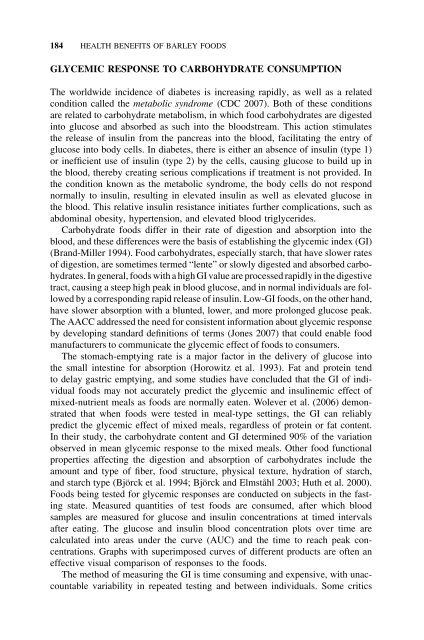Barley for Food and Health: Science, Technology, and Products
Barley for Food and Health: Science, Technology, and Products
Barley for Food and Health: Science, Technology, and Products
You also want an ePaper? Increase the reach of your titles
YUMPU automatically turns print PDFs into web optimized ePapers that Google loves.
184 HEALTH BENEFITS OF BARLEY FOODS<br />
GLYCEMIC RESPONSE TO CARBOHYDRATE CONSUMPTION<br />
The worldwide incidence of diabetes is increasing rapidly, as well as a related<br />
condition called the metabolic syndrome (CDC 2007). Both of these conditions<br />
are related to carbohydrate metabolism, in which food carbohydrates are digested<br />
into glucose <strong>and</strong> absorbed as such into the bloodstream. This action stimulates<br />
the release of insulin from the pancreas into the blood, facilitating the entry of<br />
glucose into body cells. In diabetes, there is either an absence of insulin (type 1)<br />
or inefficient use of insulin (type 2) by the cells, causing glucose to build up in<br />
the blood, thereby creating serious complications if treatment is not provided. In<br />
the condition known as the metabolic syndrome, the body cells do not respond<br />
normally to insulin, resulting in elevated insulin as well as elevated glucose in<br />
the blood. This relative insulin resistance initiates further complications, such as<br />
abdominal obesity, hypertension, <strong>and</strong> elevated blood triglycerides.<br />
Carbohydrate foods differ in their rate of digestion <strong>and</strong> absorption into the<br />
blood, <strong>and</strong> these differences were the basis of establishing the glycemic index (GI)<br />
(Br<strong>and</strong>-Miller 1994). <strong>Food</strong> carbohydrates, especially starch, that have slower rates<br />
of digestion, are sometimes termed “lente” or slowly digested <strong>and</strong> absorbed carbohydrates.<br />
In general, foods with a high GI value are processed rapidly in the digestive<br />
tract, causing a steep high peak in blood glucose, <strong>and</strong> in normal individuals are followed<br />
by a corresponding rapid release of insulin. Low-GI foods, on the other h<strong>and</strong>,<br />
have slower absorption with a blunted, lower, <strong>and</strong> more prolonged glucose peak.<br />
The AACC addressed the need <strong>for</strong> consistent in<strong>for</strong>mation about glycemic response<br />
by developing st<strong>and</strong>ard definitions of terms (Jones 2007) that could enable food<br />
manufacturers to communicate the glycemic effect of foods to consumers.<br />
The stomach-emptying rate is a major factor in the delivery of glucose into<br />
the small intestine <strong>for</strong> absorption (Horowitz et al. 1993). Fat <strong>and</strong> protein tend<br />
to delay gastric emptying, <strong>and</strong> some studies have concluded that the GI of individual<br />
foods may not accurately predict the glycemic <strong>and</strong> insulinemic effect of<br />
mixed-nutrient meals as foods are normally eaten. Wolever et al. (2006) demonstrated<br />
that when foods were tested in meal-type settings, the GI can reliably<br />
predict the glycemic effect of mixed meals, regardless of protein or fat content.<br />
In their study, the carbohydrate content <strong>and</strong> GI determined 90% of the variation<br />
observed in mean glycemic response to the mixed meals. Other food functional<br />
properties affecting the digestion <strong>and</strong> absorption of carbohydrates include the<br />
amount <strong>and</strong> type of fiber, food structure, physical texture, hydration of starch,<br />
<strong>and</strong> starch type (Björck et al. 1994; Björck <strong>and</strong> Elmståhl 2003; Huth et al. 2000).<br />
<strong>Food</strong>s being tested <strong>for</strong> glycemic responses are conducted on subjects in the fasting<br />
state. Measured quantities of test foods are consumed, after which blood<br />
samples are measured <strong>for</strong> glucose <strong>and</strong> insulin concentrations at timed intervals<br />
after eating. The glucose <strong>and</strong> insulin blood concentration plots over time are<br />
calculated into areas under the curve (AUC) <strong>and</strong> the time to reach peak concentrations.<br />
Graphs with superimposed curves of different products are often an<br />
effective visual comparison of responses to the foods.<br />
The method of measuring the GI is time consuming <strong>and</strong> expensive, with unaccountable<br />
variability in repeated testing <strong>and</strong> between individuals. Some critics

















